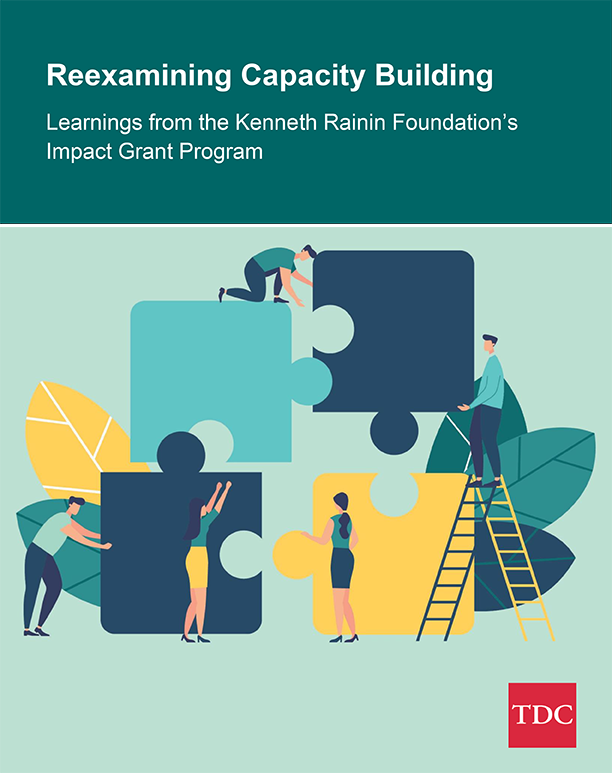The Kenneth Rainin Foundation has released Reexamining Capacity Building: Learnings from the Kenneth Rainin Foundation’s Impact Program. The report explores the experience of grantees, identifies systemic issues that affect capacity building work and offers recommendations for how similar programs can better support small arts nonprofits. It was written by TDC, a nonprofit management consulting and research firm, who evaluated the multi-year arts initiative.
The Impact Program assumed that if arts nonprofits improved their organizational performance, they would more effectively achieve their missions. In turn, this would create optimal conditions for art to be made and help strengthen the Bay Area performing arts ecosystem. From 2012-2020, the Impact Program funded 21 small and mid-sized dance, theater and multidisciplinary arts organizations with grants ranging from $25,000-$50,000 per year for three years, and an additional two years of tapered funding. Grantees developed tailored plans and had access to one-on-one coaching and outside expertise, grantee convenings, technical assistance opportunities and peer exchanges.

While the report shows that most grantees did not achieve their capacity building goals, the Rainin Foundation acknowledges that this is not a reflection of the grantee’s participation. Rather, it reveals flawed assumptions that informed the development of the program regarding the time, resources and conditions necessary for this work to be successful. What we observed throughout the program’s nine years was a group of individuals committed to thinking creatively and taking risks to make things work better for those within their organizations and for the communities they serve. This was work done with a great deal of intention, responsibility and care.
The Rainin Foundation remains committed to supporting the Bay Area’s arts ecosystem and the organizations and artists that make it what it is. The report reflects an important learning—that systemic problems require systemic solutions. We’ve since adapted our approach to addressing structural barriers in the nonprofit arts sector by investing in promising field wide work, which we hope will lead to the shifts necessary to unleash creativity and ensure Bay Area artists thrive.
Four Key Takeaways On Capacity Building
- Organizations experienced different gradations of success during the program and were well supported by the Foundation.
- The focus on organizational growth over stability was detrimental to most grantees. This is not surprising given the tremendous pressure on nonprofits to use growth as the most significant success metric. Capacity building should continue to be redefined, as it was in the Impact Program, to avoid implying that growth is necessary.
- Readiness was critical to organizations being successful in the program in addition to goals being right-sized and well-sequenced.
- A current state analysis of the organization, based on data gathering and goal setting, is essential to assess the organization’s strengths, weaknesses, opportunities and challenges and to ascertain what goals the organization could realistically achieve.
The focus on organizational growth over stability was detrimental to most grantees. This is not surprising given the tremendous pressure on nonprofits to use growth as the most significant success metric.
Systemic Issues Affect Nonprofit Growth
Although some organizations achieved success, many Impact Program participants faced systemic challenges. The following systemic issues most affect growth:
- Sweat Equity is demanded by business models that don’t work and the sector supports it. It is an idea reinforced by attitudes that undervalue artists’ labor.
- Major donor support is not always present in a community or is at odds with social justice values. For organizations facing this issue, replacing capacity building or general operating funds from foundations at a program’s end is very difficult.
- Small organizations often cannot scale functions such as marketing or development. Each role needs technical expertise that requires salary and budgets beyond their means.
The report reflects an important learning—that systemic problems require systemic solutions.
How Capacity Building Can Better Support Arts Nonprofits
TDC advocates for capacity building if it includes a funded, in-depth diagnostic and a goal-setting phase followed by tailored funding extending beyond five years. It recommends adapting capacity building efforts to meet the specific needs of each organization. Funding could be ongoing or temporary, general operating or project-based support, or primarily about sustaining current operations or backfilling to decrease sweat equity. For small organizations, ongoing unrestricted general operating support may be more effective than capacity building programs. The key is to meet organizations where they are, tailoring the support and creating trusting, open relationships with clearly defined and shared objectives.
The key is to meet organizations where they are, tailoring the support and creating trusting, open relationships with clearly defined and shared objectives.

